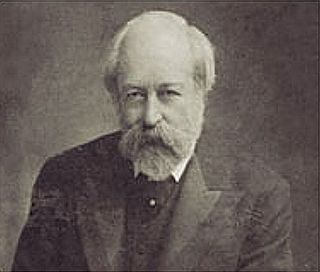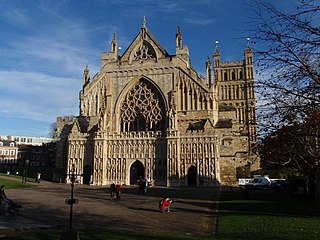
Piran or Pyran, died c. 480, was a 5th-century Cornish abbot and saint, possibly of Irish origin. He is the patron saint of tin-miners, and is also generally regarded as the patron saint of Cornwall, although Michael and Petroc also have some claim to this title.

Henry Martyn was an Anglican priest and missionary to the peoples of India and Persia. Born in Truro, Cornwall, he was educated at Truro Grammar School and St John's College, Cambridge. A chance encounter with Charles Simeon led him to become a missionary. He was ordained a priest in the Church of England and became a chaplain for the British East India Company.

Petroc or Petrock was a British prince and Christian saint.

George Frederick Bodley was an English Gothic Revival architect. He was a pupil of Sir George Gilbert Scott, and worked in partnership with Thomas Garner for much of his career. He was one of the founders of Watts & Co.
Charles Gordon Henderson was a Cornish historian and antiquarian.

Lanreath is a civil parish and a village in southeast Cornwall, England, United Kingdom. The village is situated five miles (8 km) west-northwest of Looe. The name Lanreath means 'church (Lann) of Raydhogh' and it has been known variously as Lanreythow, Lanrathew, or Lanrethou. The village is mentioned in the Domesday Book as Lanredoch.

Keyne was a 5th-century holy woman and hermitess who was said to have travelled widely through what is now South Wales and Cornwall.

St Enoder is a civil parish and hamlet in Cornwall, England, United Kingdom. The hamlet is situated five miles (8 km) southeast of Newquay. There is an electoral ward bearing this name which includes St Columb Road. The population at the 2011 census was 4,563.

St Veep is a civil parish in Cornwall, England, United Kingdom, situated above the east bank of the River Fowey about three miles (5 km) south-east of Lostwithiel. It is bordered by the parishes of St Winnow to the north-west, Boconnoc to the north, Lanreath to the east Polperro to the south-east and Lanteglos to the south. The River Fowey forms its western boundary. The parish is named after Saint Veep of whom little is known.

Crowan is a village and civil parish in Cornwall, England, United Kingdom. It is about three-and-a-half miles (6 km) south of Camborne. A former mining parish, all of the mines had shut by 1880.
St Kew is a village in Cornwall, England, United Kingdom. It is also the name of the civil parish, which includes the church town, St Kew, and nearby St Kew Highway.

Herodsfoot is a village in southeast Cornwall, England, United Kingdom. It is situated approximately four miles (6 km) southwest of Liskeard and five miles (8 km) north of Looe at a point where two tributaries of the West Looe river join. It is in the civil parish of Lanreath
Wyllow was a Cornish hermit saint and martyr whose existence was reported by William Worcester.

Morval is a rural civil parish, hamlet and historic manor in southeast Cornwall, England, United Kingdom. The hamlet is approximately two miles (3 km) north of Looe and five miles (8 km) south of Liskeard.

St Pinnock is a hamlet and civil parish in southeast Cornwall, England, United Kingdom, 3 miles (5 km) south-west of Liskeard. Other settlements in the parish include East Taphouse, and Penfrane, containing 421 inhabitants. The parish church, dedicated to St Pynnochus (Winnoc), is located at OS Grid Ref SX200630.

Talland Church is a Grade I listed building located on the cliff-top at Talland near Looe in Cornwall. It is dedicated to St Tallanus and was built by Augustinian monks from Launceston.

Maudez is a Breton saint who lived in the 5th or 6th century. He is also known as Maudé, Maudet, Maodez or Modez (Breton), Maudetus (Latin), Mandé (French) and Mawes. In the Breton calendar his feast is 18 November.
Rev. Thomas Tregosse of Cornwall was a Puritan minister and vicar of the Rebellion period who was silenced for being a Nonconformist.
Mybbard and Mancus were two Cornish saints of the 6th century.

Nicholas Marston was a 16th century English priest. It is uncertain whether his appointment as Archdeacon of Cornwall in 1574 took effect. He was one of three brothers, who had ecclesiastical careers in the Cathedral church of Exeter, and in that diocese within Cornwall and Devon. Their father was a wealthy citizen Haberdasher in the city of London who gave financial support to the early career of his wife's brother William Bradbridge, later bishop of Exeter. Thomas's daughters made advantageous City marriages, and the network of their mercantile patronage and relations with the bishops, deans and chapters of Exeter and of Bath and Wells, and with the University of Oxford, spanned several decades of the Tudor and early Stuart period.















